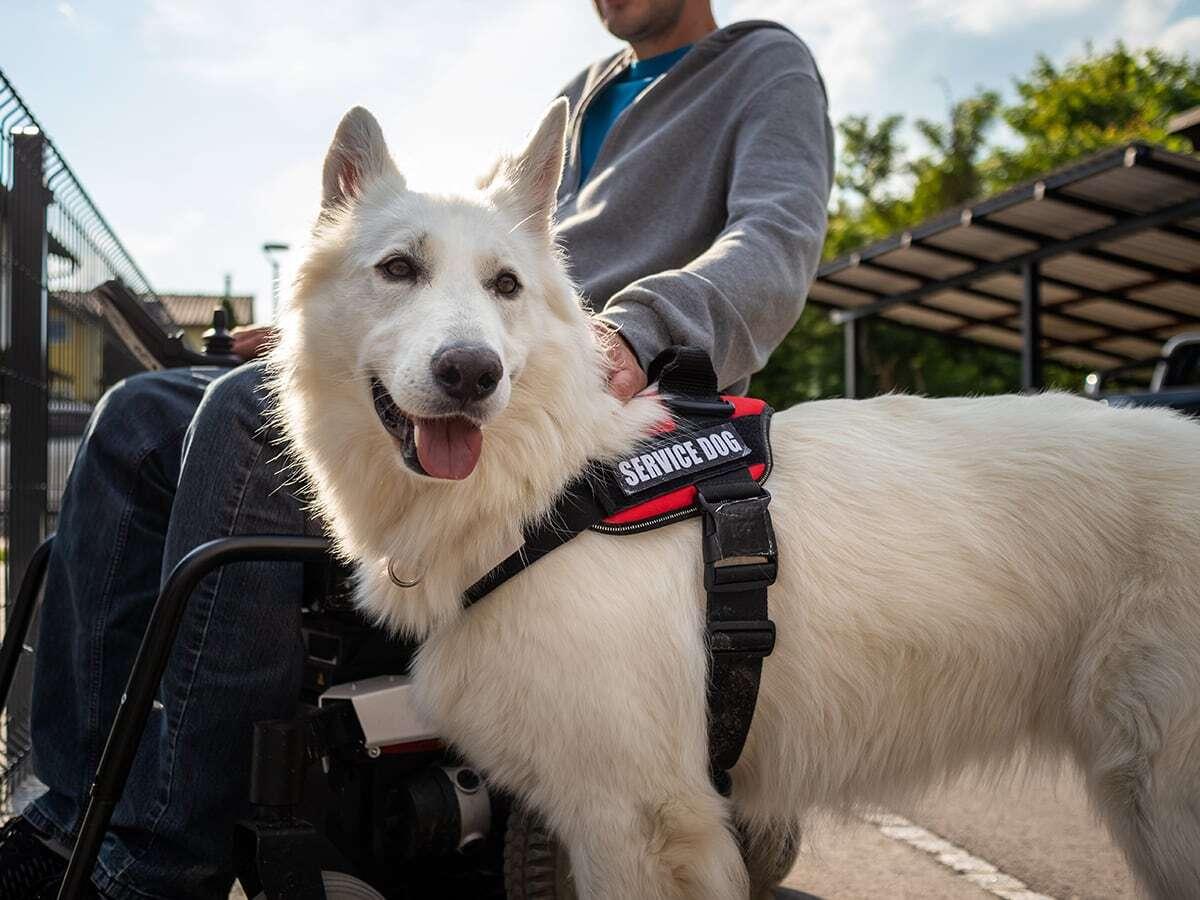Service Dogs Have a Profound Impact On Our Wellbeing
They say that a dog is a human’s best friend, but the relationships formed between service dogs and humans can transcend a typical pet companionship.
Service dogs are a stabilizing presence in the lives of millions of people around the world. They are trained to create better lives for their human halves, physically, mentally, and emotionally. From this, a special human-animal bond forms into something more than a mutually beneficial relationship - a life-long friendship.
In this article, we share some inspirational stories from service dog organizations about bonds between people and their trusted super dog companions.
What is a Service Dog?
Chances, most have an idea of what a service dog is, but few know their full capabilities. The American Disabilities Association (ADA) defines a service dog as “dogs that are individually trained to do work or perform tasks for people with disabilities.”
Service dogs can be trained to work with people of all mental, physical, or emotional disabilities. They can be paired with both kids and adults. These dogs are well-mannered at all times and are trained to perform and handle daily tasks that aid a disability.
A service dog is one of several types of working dogs. Other common types of working dogs include emotional support and therapy dogs. While other working dogs provide services to people, service dogs are trained to meet the needs of individuals with various disabilities.
Best Breeds for Service Dogs
While there are no breeds that are officially recognized as service dogs, there are several breeds that are commonly trained to become service animals. These dog breeds are selected because they possess certain traits and characteristics that make them well-qualified to be trained as service dogs.
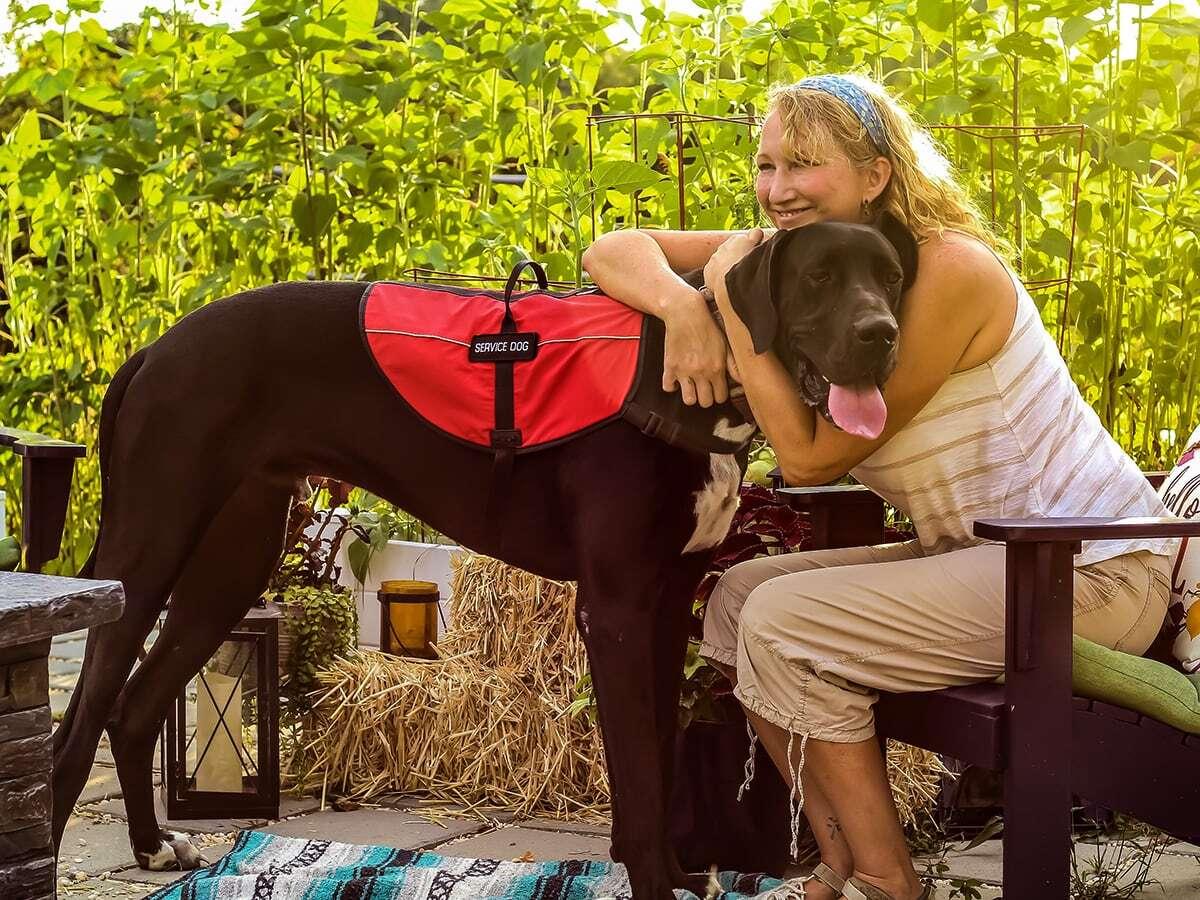
Breed traits & characteristics
Before we get to the top breeds, it’s worth noting the traits and characteristics required in a breed to become a service dog. These dogs need to have the right trainability and temperament, and only select breeds meet that criterion. Here are the traits of a dog that help them make great service animals:
Intelligent: perhaps the most important trait, service dogs must perform complex tasks.
Strong bond: the tendency to form a strong bond with their human half.
Friendly: service dogs should be not only friendly to their human half but other people in public settings.
Calm: service dogs possess a calm demeanor, particularly when acting in emergency situations.
Driven: these trained dogs should have a strong desire to help their human halves.
Physical ability: when it comes to their physical duties, service dogs must have the stature and ability to withstand physically demanding tasks.
Enthusiasm: service dogs must love what they do, which is helping people with tasks to improve their lives on a daily basis.
Top service dog breeds
What are the best breeds for service dogs? Certain service dogs require different skills for different physical, emotional, and mental health diagnoses that not every breed is cut out for. Here is a list of the top dog breeds and the traits and characteristics they have that make them well-suited to be service dogs.
Labrador retrievers
Labrador retrievers make excellent service dogs because they are friendly and good-natured. They are both intelligent and have the physical stature, making them ideal to become any type of service dog.
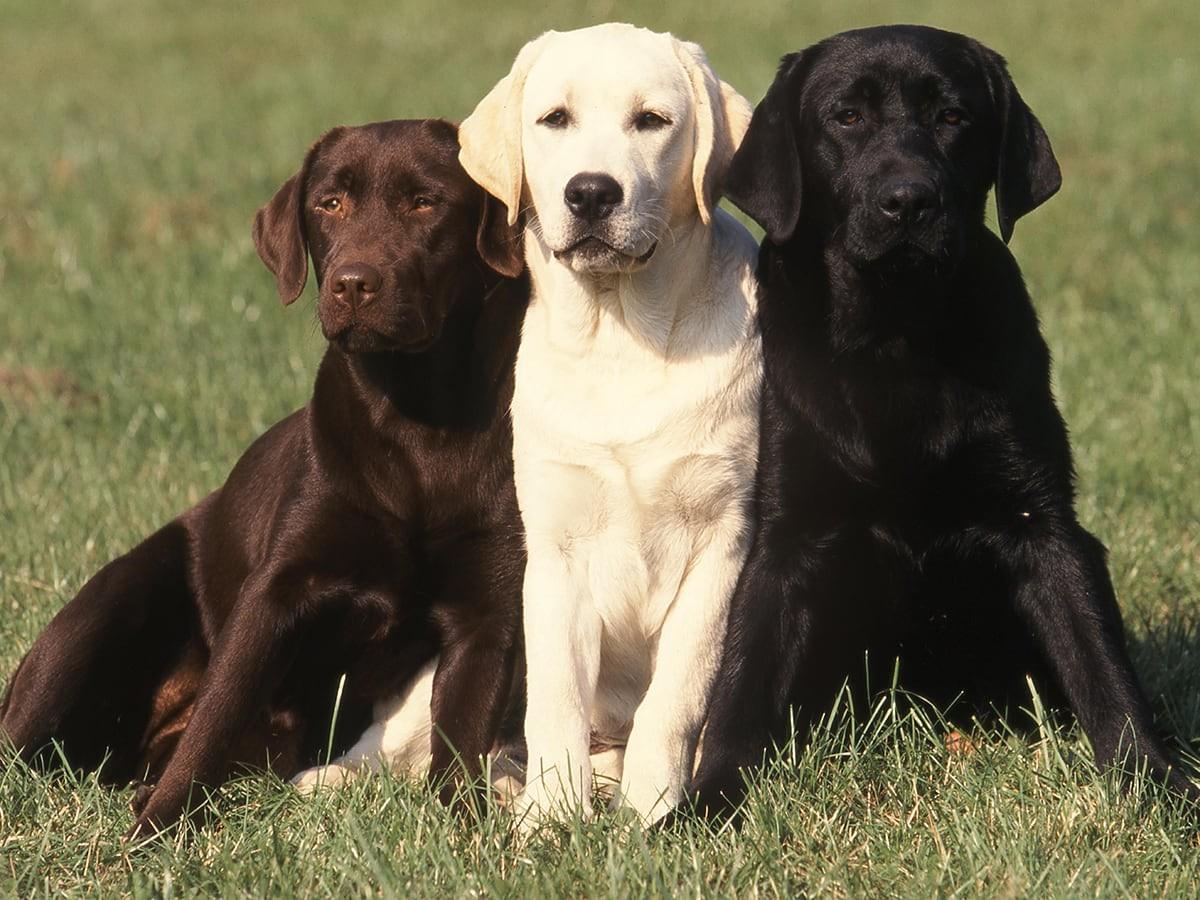
Golden retrievers
Golden retrievers have many redeeming traits to be service dogs. They are one of the most intelligent and friendly dog breeds. Another common reason they are often selected is the fact that they excel in training. They form strong bonds with their human halves and are gentle and sweet, which can help to reduce anxiety. Like lab retrievers, golden retrievers are great for any type of service dog.

German shepherds
As a breed, german shepherds are intelligent, well-behaved, and easy to train. They are known to form strong bonds with their human halves. They are also exceedingly focused and have a powerful sense of smell, which makes them well-suited to monitoring blood sugar levels. They are great as several service dog types but excel as Diabetes alert dogs.

Poodles
As a breed, poodles may seem like a surprising choice, however, but they possess many characteristics needed to become a service dog. Some traits that Poodles typically have are a great demeanor, high intelligence, and being easy to train. They are great as any type of service dog.
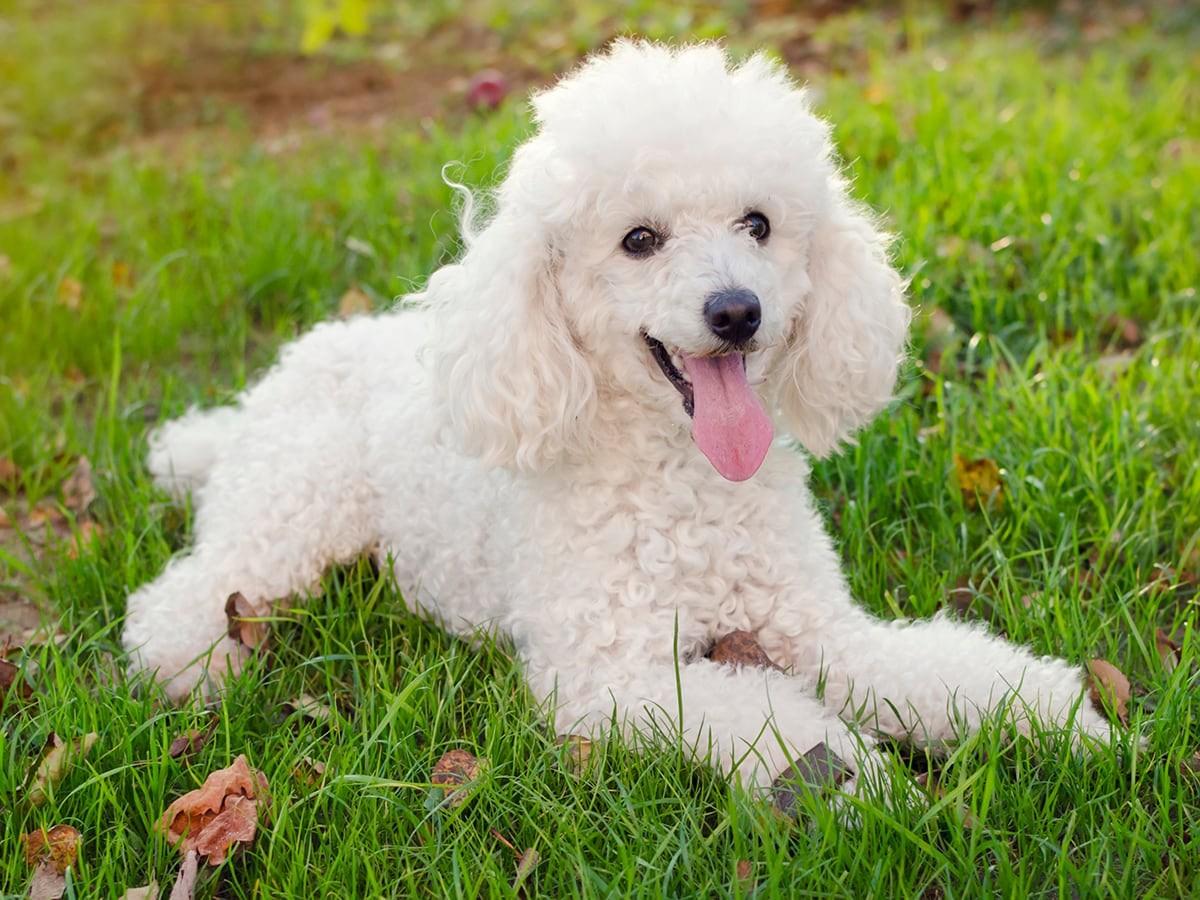
Border collies
Border collies are generally very smart dogs. They are also naturally playful, loyal, and are eager to please their human companions. While they are well-suited to be several service dogs, their traits align well with treating those with Autism.

Other choices:
Boxers: though they are less commonly trained as service dogs, boxers exhibit most of the traits that you want in a service dog, including being friendly to both adults and kids.
Great Danes: this breed is a great service dog because of its size, strength, and health. Best for mobility assistance dogs.
Bernese Mountain Dogs: this breed has some important traits to look for in a service dog, including being friendly and intelligent and having a strong work ethic.
Saint Bernards: Dubbed a gentle giant, saint bernards are patient, gentle, and sweet with small children.
Pomeranians: one of the smaller breeds, Pomeranians are calm, affectionate, and love to meet people, making them great for autism and other developmental issues.
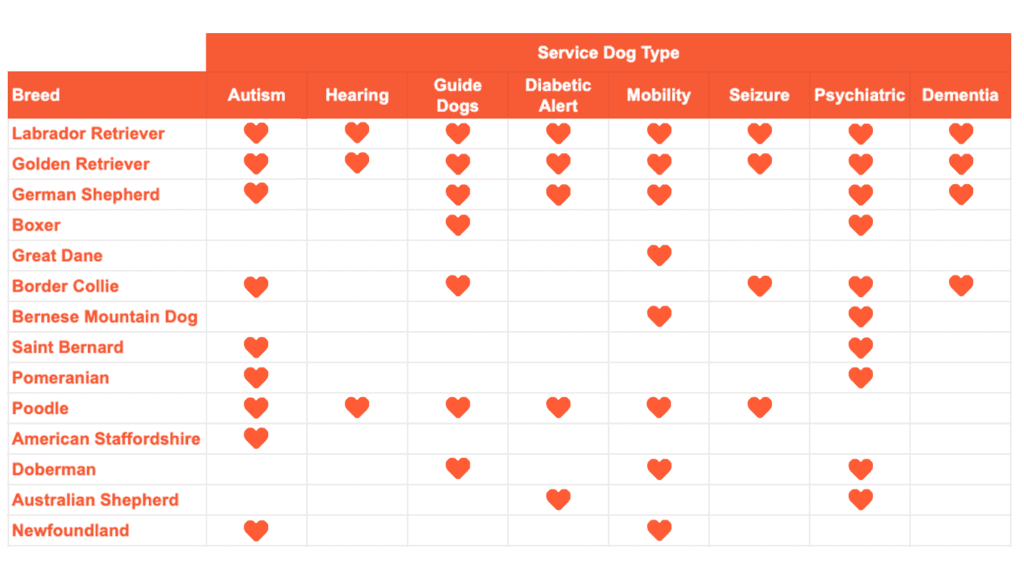
Types of Service Dogs
There are several types of officially-recognized service dogs that are trained to handle certain responsibilities. To get some more information on each type, we reached out to several service dog organizations. They provided some more insight into how they are trained and matched with their human companions and stories about unbreakable bonds formed. If you’re interested in donating during the holiday season, consider donating to one of these wonderful organizations. Below are the most common types of service dogs:
1.) Hearing Dogs
Hearing dogs are trained to work with people who are deaf or hard of hearing, alerting them to specific sounds. These dogs are trained to respond to environmental sounds like a phone ringing, door knocking, or doorbell. They also alert their deaf or hard-of-hearing pet parents if something is happening in the environment that they need to notice (like a smoke alarm, crying baby, etc.)
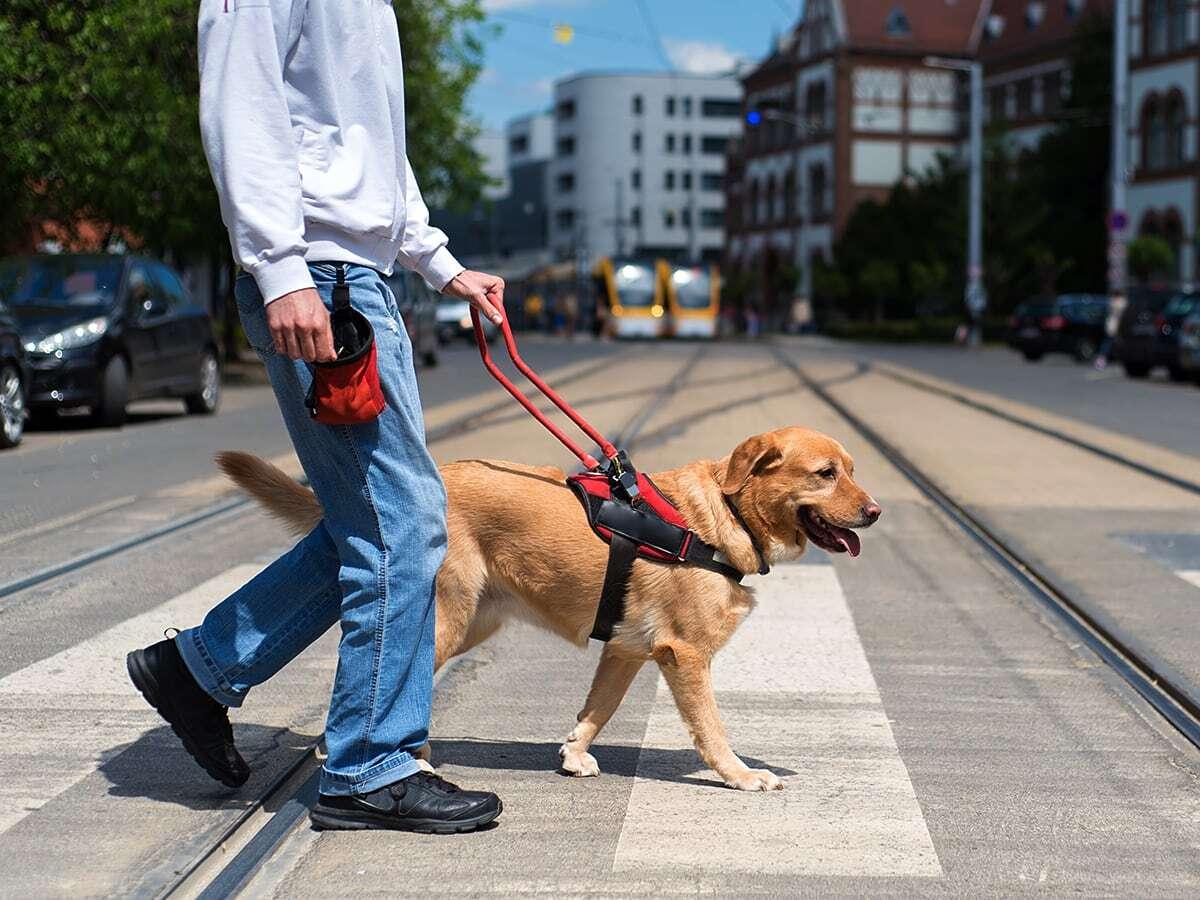
2.) Guide Dogs
One of the most commonly-known service dogs, guide dogs, are trained to respond to environmental guidance cues; they help their pet parents avoid obstacles and navigate safely. These dogs are specifically trained to guide around various perils that might include stairs, curbs, inclines or declines, elevators, escalators, or even doors.
Featured organization: Guide Dogs of America
About our guide dogs:
“Guide Dogs of America provides highly-skilled guide dogs to people who are blind or visually impaired at no cost to them. Their dogs become trusted companions that bring new opportunities for life experiences and social interaction, as well as greater confidence and independence.”
“Our guide dogs for people who are blind/visually impaired improve our clients’ mobility and bring new opportunities for life experiences and social interaction. These highly trained canines help our clients travel safely from one destination to the next, avoid obstacles, stop at changes in elevation and for all oncoming traffic, as well as remember common routes.”
“Our trainers are experts at pairing students with the right canine partner, with special consideration given to their personalities and unique characteristics, work and home environments, physical abilities, and a variety of other factors. We like to call it, ‘The Magic of the Match’.”
– Mariah A. Romo, Guide Dogs of America
Success story: Captain & Lorri
Lorri Bernson stands at the corner, patiently waiting to cross the bustling intersection outside her apartment. With her is a beautiful yellow Labrador guide dog named Captain, who’s been training his entire life for this moment to keep Lorri safe.
Captain was a perfect match for Lorri’s needs, traits, and lifestyle. After being matched, the two have learned how to work as a team. As Lorri’s guide dog, Captain’s main job is to help Lorri get safely from one destination to the next. He is trained to avoid obstacles and stop at changes in elevation, like curbs or stairs. Captain even remembers Lorri’s daily and weekly routes, like getting into the office or going to the bus stop.
“Because of the bond we share, the trust I have in him is incomparable. With Captain, it’s not about what I can’t do; it’s what I can do.”
To Lorri, Captain has become more than her guiding eyes and trusted companion; he is a bearer of confidence and independence. So, although Lorri cannot see, Captain allows her to accomplish what others may find impossible.
More about Guide Dogs of America:
Guide Dogs of America transforms lives through partnerships with service dogs. We breed, raise, and train guide dogs for individuals who are blind/visually impaired and service dogs for veterans and children with autism.
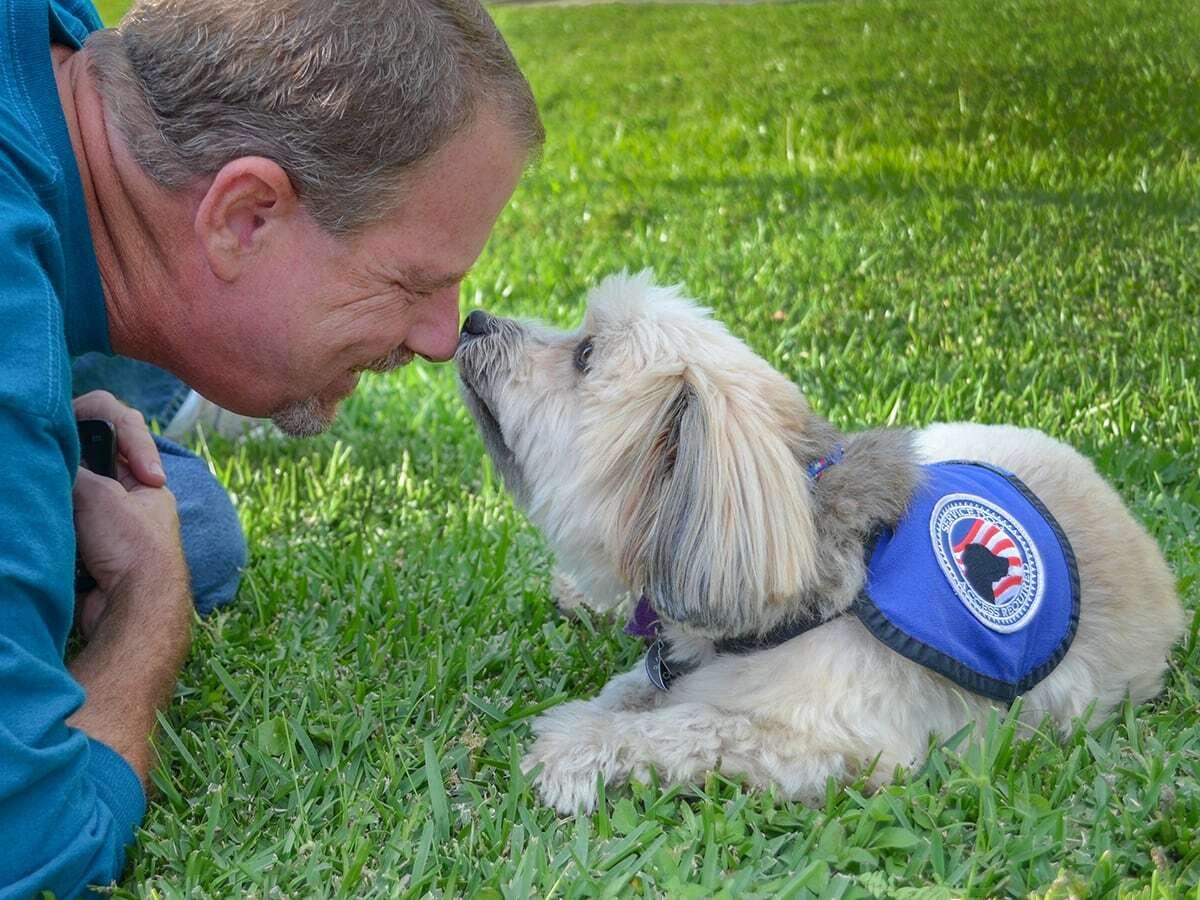
3.) Diabetic Alert Dogs
Diabetic Alert Dogs provide real and measurable help for people with insulin-dependent diabetes. Hypoglycemia is an inevitable and acute side-effect of insulin therapy that can lead to severe medical problems, including coma and death, so it is imperative for diabetics to receive the earliest warning possible when their blood glucose is dropping. Though modern medical technology makes it possible for a person to regularly test and verify their blood sugar levels, there are many times when such checks are problematic or even impossible.
Featured organization: Early Alert Canines
About our diabetic alert dogs:
“Our organization trains dogs to alert people with diabetes, who are insulin-dependent, when they detect low or dropping blood glucose levels. The dogs recognize these conditions using their superior sense of smell, which can help avoid dangerously low blood glucose levels. A Diabetic Alert Dog will alert a person to an impending shift in their blood glucose levels, giving them plenty of time to ascertain the gravity of the problem and take the necessary precautions or treatment. The dog will alert in any location, under nearly any circumstances, and even wake their diabetic partner in the middle of the night if necessary.”
“An early alert to shifts in blood sugar is a major relief to insulin-dependent diabetics, especially the parents of a child with diabetes, who struggles to identify such changes before they result in uncomfortable symptoms and eventual debilitation. It is an invaluable tool in the effort to achieve and obtain optimal blood sugar levels, and in many cases, serves as a life-saving warning. Our dogs are a diabetic’s best friend, life-saver, and life-changer.”
– Victoria Briskin at Early Alert Canines
Success story: Chrystal & Leslie
Going through a pregnancy with type 1 diabetes can be stressful. Chrystal has had two healthy pregnancies and attributes this to Leslie, her Diabetic Alert Dog and the “love of her life”. Leslie won’t allow Chrystal to go to sleep until her blood sugar levels are within range. A lot of women with diabetes decide not to have children. Leslie helped Chrystal have healthy pregnancies and was even in the hospital right at her bedside.
“The biggest difference I can identify between other pregnant diabetics and me is that I have Leslie. In several support groups, I haven’t met one other pregnant diabetic who has an alert dog yet. This dog has given me an opportunity to live the most normal life possible and experience everything to my fullest capabilities without any restrictions. I can’t even imagine what life would be like without her. She’s my queen,” shares Chrystal.
More about EAC:
Early Alert Canines (EAC) improve the health, safety, and well-being of people with insulin-dependent diabetes through partnerships with certified low-blood sugar alert dogs. They train and provide Medical Alert Service Dogs to insulin-dependent diabetics who need them.
4.) Autism Service Dogs
These dogs are primarily used by families who have children with autism. These dogs are trained to help children with autism deal with everyday events that can be difficult for them. They are also trained to provide deep pressure therapy to their autistic handlers, which helps calm them down during distress. Beyond training, these service dogs can provide a sense of comfort and predictability for people with autism while improving emotional control and boosting confidence.
Featured organization: 4 Paws for Ability
Success story: Rusty & Veela
Meet Rusty and Veela. Before 4 Paws, we had trouble with Rusty running away from us in public places. Tethering with Veela has been such a blessing to Rusty and his family. We go out with the family often, and Rusty is very content to be with Veela. I am the third person in our trio, and I always know where both of them are. Having Veela relieves the anxiety we had before. Veela and 4 Paws for Ability have been life-changing!
More about 4 Paws for Ability:
4 Paws for Ability is a 501(c)(3) non-profit organization that enriches the lives of children and adults with disabilities by the training and placement of quality, task-trained service dogs to provide increased independence for the partner and assistance to their families. We have placed over 1500 service dogs worldwide. For more information, visit: 4pawsforability.org or follow us on Facebook and Instagram at 4pawsforability!
5.) Mobility Assistance Dogs
These dogs may be a bit more familiar to people who have seen a dog carrying a small bag for an elderly handler. These dogs are specially trained to perform various tasks associated with walking, such as picking up dropped items or opening and closing doors. Typically, these dogs will partner with spinal cord injuries, brain injuries, cerebral palsy, muscular dystrophy, and arthritis.
Featured organization: Can Do Canines
About our mobility assist dogs
“While the needs of each client can vary, our Mobility Assist Dogs are trained to open and close doors, pick up dropped objects, activate push plates, carry small objects, turn light switches on or off, retrieve a phone or other important items, and more.
“Choosing a dog for each particular client is a careful, thoughtful process and not a ‘one-size-fits-all’ type of approach. First, every dog chooses the service area they feel called to do. Our organization performs certain assessments with each one to see what their true passion really is. Then, the Client Services team works with each client to determine the specific skills a dog could potentially perform to best support that person’s needs. We take great care in pairing the perfect dog with each individual.”
– Caren Hansen, Can Do Canines
Success story: Amy & Mosby
Amy, who has cerebral palsy, previously had a service dog of 8 years named Dinger, who passed away in 2020 from cancer. Amy was heartbroken and felt like she couldn’t return to a life without a service dog to help with balance issues, fatigue, sensory integration issues, and other challenges with cerebral palsy.
Mosby, Amy’s new service dog, quickly answered the call, easing Amy’s anxiety. Mosby immediately helped Amy transition from adaptive equipment into using a walker. The transition hasn’t always been smooth for Amy, and when she gets frustrated, Mosby knows to cheer her up and lift her spirits with kisses.
“Mosby has been helping me to integrate the equipment both physically and emotionally. I think he’s been very good at helping me think my way through those situations. It’s more of a team effort than I was expecting, which is wonderful.”
Thanks to Mosby, Amy has regained the independence and confidence to start considering bigger life opportunities like buying her own house, going to graduate school, and transitioning to a new career.
“I’ve had dogs my whole life, so I’m very, very aware of just how fast and hard those bonds can form. I’m unspeakably grateful to all the people who have touched Mosby and loved him and then made the conscious choice to give him up so that he can be with me. This dog isn’t my pet. He’s quite literally the life the way I want and choose to live it.”
More about Can Do Canines:
Can Do Canines (CDC) provides specially trained dogs, for free, to clients with mobility challenges, hearing loss or deafness, seizure disorders, diabetes complicated by hypoglycemia unawareness, or childhood autism. Since 1989, they have provided more than 750 service animals to adults and children in Minnesota or Wisconsin living with disabilities.
6.) Seizure Alert Dogs
These dogs help their handlers by providing a natural early warning system for seizures. These dogs are trained to respond to pre-seizure symptoms and warn or protect their handler before a seizure occurs by using environmental and body cues.
Featured organization: Guardian Angels Medical Service Dogs
About seizure alert dogs:
“Our program utilizes both rescue dogs and our selective breeding program. Each dog is lovingly guided through up to two years of positive-reinforcement training, as they learn to meet the exacting needs of their future recipient. These tasks can include alerting to oncoming events such as seizures, diabetic changes, and panic attacks, shielding recipients in public, retrieving dropped items, opening, and closing doors, and assisting with mobility and balance issues. The cost to train each service dog, and pair them with their person is approximately $25,000, but every one of our service dogs is donated to their recipients at no cost.”
– Christine Patrick, Guardian Angels Medical Service Dogs
Success story: Gina & Rhino
Gina was a former first responder, who developed epilepsy. Without the auras that can precede a seizure, Gina had no warning and was badly injured when a grand mal seizure nearly took her life one day while shopping. She broke her jaw and woke up in a hospital as a “Jane Doe” not knowing what had happened.
That was in 2017. In 2018, Gina was paired with Service Dog Rhino. When Rhino senses Gina has a seizure coming, he will circle around her. If she doesn’t pay attention, Rhino will put his front paws on her shoulders until she lays down. Once the seizure begins, Rhino will get behind her back to keep her on her side (which keeps her airway open). Then he will place his head under hers, to keep her from hitting her head. When the seizure slows, Rhino will tap his paws on her emergency alert button, and bark into the microphone until help arrives. Then he will retrieve her medication and lay it in front of her.
More about Guardian Angels:
Guardian Angels Medical Service Dogs has a mission to rescue, raise, train and then donate individually trained medical service dogs for veterans, first responders and civilians, who are struggling with disabilities that are both visible and invisible. These include, but are not limited to PTSD, Traumatic, Brain Injury, Seizure, and Diabetic disorders, and mobility issues. We utilize both rescue dogs and our selective breeding program.
7.) Psychiatric Service Dogs
These dogs are trained to assist their handlers who have psychiatric disabilities and may be heightened anxiety. This includes those diagnosed with mental health issues, varying from depression, anxiety, and PTSD (post-traumatic stress disorder). Amazingly, these dogs can sense a change in their guardian when they’re about to experience an episode such as an anxiety attack or a flashback. Psychiatric service dogs help their human half manage many aspects of daily living, such as waking them from nightmares or flashbacks, reminding them to take medication, and providing assistance with dissociation.
Featured organization: America’s VetDogs
About our psychiatric service dogs:
“The service dog programs of America’s VetDogs® were created to provide enhanced mobility and renewed independence to United States veterans, active-duty service members, and first responders with disabilities, allowing them to once again live with pride and self-reliance. When puppies are 8 weeks old, they go to live with specially chosen inmates at the correctional facilities that have partnered with America’s VetDogs. For the next year, under the direction of our instructors, the pups will follow a service dog curriculum, which means inmates will teach them not only basic obedience, they will also teach them how to do specific tasks such as turn on lights, open doors, and retrieve dropped items.”
“On weekends, the pups live with weekend raisers to gain the socialization experiences not found within a prison environment. Weekend raisers are responsible to socialize puppies, bringing them everywhere they go, putting them in as many different environments as possible. They are also exposed to many different situations, including schools, busy pedestrian areas, other animals, and interaction with children. A well-socialized puppy will have fewer adjustments to make when it comes back to VetDogs for formal service dog training.”
“Once they make the decision to get a service dog, applicants become part of VetDogs’ open and welcoming community. Students will come to our campus to attend a two-week in-residence training program. Classes are kept small to ensure personalized attention for each student and their new dog. During the program, the student and dog bond and learn how to work together as a team. They are supported with an uncompromising commitment to excellence, from highly empathetic and certified trainers to a meticulously constructed curriculum.”
– Allison Storck, America’s VetDogs
Success story: Rhonda & Tony
With the help of his wife, Tony recognized that the types of situations that he experienced in Iraq were less than “normal” as compared to my civilian peers. He suffered from extreme hypervigilance, flashbacks, paranoia, rage, depression, anxiety, insomnia, nightmares, TMD, trouble interacting with others, avoidance, and self-isolation.
Tony began to realize that treating the symptoms by numbing my mind with medication was not a sustainable solution, and was ready for a change. Upon doing research for alternate types of therapy, service dogs were helping veterans deal with their symptoms.
Tony was not prepared for the depth of the emotional bonding when he met his service dog, Rhonda.
“It was one of the most humbling experiences of my life to be given a gift that so many people had invested their time and effort into the dog and to me. I have never won the lottery but I think that Rhonda was not just my winning lottery ticket but a Mega-Healing-Gift my family and I.”
Rhonda has greatly helped Tony by reducing symptoms of PTS. Her presence pushes Tony, inspiring him to be a better version of himself, and improving the lives of his family.
“She is the antidote for Social Isolation. She gets me out of my ‘shell’. When I interact with others it allows me the opportunity to choose what parts of myself I want to share with others.”
More about America’s VetDogs:
Since 2003, America’s VetDogs (www.VetDogs.org) has trained and placed guide and service dogs to provide independence, enhanced mobility, and companionship to veterans with disabilities from all eras. America’s VetDogs is a 501(c)(3) not-for-profit organization founded by the Guide Dog Foundation and serves clients from across the United States.
8.) Service Dogs for Dementia
These dogs are trained to help their handlers who have dementia overcome some of the problems they might encounter daily, such as safely getting back inside after wandering or reminding them to take their medication. These dogs are especially beneficial for people who live alone and may not get outside assistance if needed.
Conclusion
Service dogs play a huge part in assisting their human halves. Their capabilities are truly amazing, and they are trained to help us get through daily tasks. We want to make sure that you are doing everything you can to take care of them in return, which includes dog insurance. At Spot, we are proud to offer pet insurance for service dogs.

With 15 years as a dog and cat parent, my pet articles are a mix of humor and firsthand experience - proof that the best stories often come with paws and purrs.
